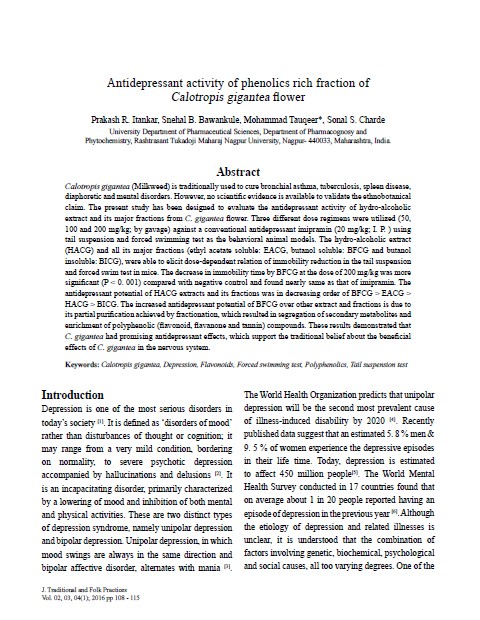Antidepressant activity of phenolics rich fraction of Calotropis gigantea flower
Keywords:
Calotropis gigantea, Depression, Flavonoids, Forced swimming test, Polyphenolics, Tail suspension testAbstract
Calotropis gigantea (Milkweed) is traditionally used to cure bronchial asthma, tuberculosis, spleen disease, diaphoretic and mental disorders. However, no scientific evidence is available to validate the ethnobotanical claim. The present study has been designed to evaluate the antidepressant activity of hydro-alcoholic extract and its major fractions from C. gigantea flower. Three different dose regimens were utilized (50, 100 and 200 mg/kg; by gavage) against a conventional antidepressant imipramin (20 mg/kg; I. P. ) using tail suspension and forced swimming test as the behavioral animal models. The hydro-alcoholic extract (HACG) and all its major fractions (ethyl acetate soluble: EACG, butanol soluble: BFCG and butanol insoluble: BICG), were able to elicit dose-dependent relation of immobility reduction in the tail suspension and forced swim test in mice. The decrease in immobility time by BFCG at the dose of 200 mg/kg was more significant (P < 0. 001) compared with negative control and found nearly same as that of imipramin. The antidepressant potential of HACG extracts and its fractions was in decreasing order of BFCG > EACG > HACG > BICG. The increased antidepressant potential of BFCG over other extract and fractions is due to its partial purification achieved by fractionation, which resulted in segregation of secondary metabolites and enrichment of polyphenolic (flavonoid, flavanone and tannin) compounds. These results demonstrated that C. gigantea had promising antidepressant effects, which support the traditional belief about the beneficial effects of C. gigantea in the nervous system.


